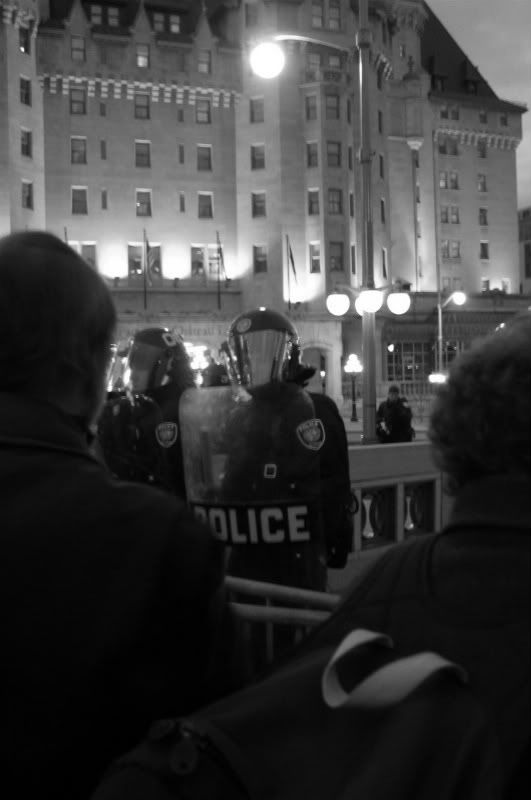In my previous post, I talked about how four RCMP officers were responsible in taking Robert Dziekanski’s life away. After his death, the RCMP was adamant that their officers had followed protocol. It was only after the video of the incident was released the public saw what had really happened; unknowingly, this video ‘opened the door’ to a host of RCMP’s problem. This video was the main catalyst behind the Braidwood Inquiry; this public inquiry was set-up to investigate what happened that unfaithful day. In this post, I will try to link the actions of these four officers to what we know about police deviance and police culture.
To this day some people argue that the police should be able to ‘bend’ or manipulate the law because they have “hard” job. The premise of this statement is fundamentally wrong in our society; no-one is above the law. Even though Dzienkanski’s death was clearly a criminal act perpetuated by the police officers, none of them were charged; even after intense public uproar, nothing happened. This lead to a fundamental debate in our society: should the police investigate themselves? Some emphatically support this notion because they feel police are ‘upholders’ of the law and will be objective to their findings. However, I feel this is ideology is flawed for three reasons: there is often a conflict with the official paradigm and operational paradigm, “blue wall” of silence inhabits objectivity, and often times it is a systemic institutional failure.
“[O]ffical paradigm is shaped to bolster institutional values, whereas the operational code espouses how things ‘really get done” (Maurice Punch 2009: 3). This situation is a classic example of this conflict. Immediately after the incident the RCMP’s Integrated Homicide Team (IHIT deliberately released information that would have shown their officers in a favourable light (Braidwood 2010: 41). This was in direct violation of their institutional core values. Most RCMP officers still believe that the officers involved in Dziekanski’s death did the right thing under the circumstances because Dziekanski did not follow the officer’s orders. In my opinion, it is well-known that police officers are usually taught by the ‘book’ in the police academy, and when the recruit comes in contact with a field trainer, he is taught to ‘throw-out’ whatever he learned in the academy. When an officer is on the job, he is usually taught be his peers that if anyone challenges his authority he better put the ‘perp’ in his place; this is more commonly known as “contempt of cop” (Washingtonpost.com). As much as police officers would like to think “contempt of cop” is a crime, the reality is that it is not; the courts have been firmly against this notion, as well. For example, a recent court decision by an Ontario Court found that “it is not against the law to be rude to an officer” (politicsanditsdiscontents.blogsopt.com). The disparities between the official paradigm and operational paradigms need to be looked at, if we, as a society, are to move forward in the 21st century.
The public has often debated whether the “blue wall” of silence inhibits objectivity? In my opinion, the “blue wall” does hamper objectivity; in fact, this holds police agencies together (Punch 2009: 37). Entire police culture is based on this notion. Any officer that breaks this rule is dealt with severely. For example, when a NYPD officer, Serpico, spoke out against the wide spread corruption within his organization, he was vilified by his colleagues. Even when officers are take part in criminal activities, no-one says anything. For example, the four officers caught on tape tasering Dzienkanski for no reason were never charged. Not a single officer came forward to testify against the officers involved; these officers tasered another human being with 50,000 volts of electricity and were never charged. The RCMP was keen to argue that Tasers do not kill. However, the Braidwood Inquiry found that Tasers do kill people; the courts concured. The company that manufactures these Tasers, Taser International, stated that Tasers are safer than high school sports (Taser.com). The only reason these officers were caught because we live in new era of ‘visible policing.’ “Video capture of images for mass dissemination, repeat viewing and popular debate enables mass mobilization of affect and discussion…” (Andrew Smith Goldsmith 2010: 925).
Some people argue that it is always a few ‘rouge’ officers that are to blame. However, I feel this statement hold no merit. History has repeatedly shown that the entire institution is usually to blame. Once a police officer becomes part of a police organization, his views start to transform into the institutions ‘views; no-one comes into policing with a deviant mind, it is over time that his views start to shift. For example, a newly sworn police officer will do everything by the ‘book’ at the start of his career. However, as his/her career progresses temptation and peer pressure will usually lead him/her towards deviancy. This is more commonly known as “inclusion.” Once an officer goes down this road the pathway towards a
deviant career becomes easier and easier (slippery slope). Therefore, it is ‘ill-advised’ to blame individuals for their deviant behaviours; it is the entire system that is corrupt.
This blog post is not meant to entice hatred towards the police. The purpose of this blog post is to educate the reader on the ‘dark’ side of policing. Police services are an essential part of our society and we, as a society, need to find ways to improve our system.
Refrences:
1. Punch, M. (2009). Police corruption. Portland, Oregan: Willan Publishing.
2. Goldsmith, A. J. (2010). Policing’s new visibilty. British Journal of Criminology, 50, 914-934.

